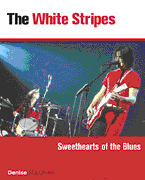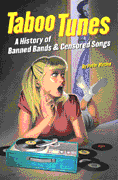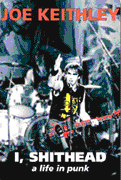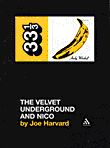


As the subtitle says, this is a collection of interviews that Todd Taylor (who's done time with Flipside and, currently, Razorcake) has conducted with the likes of Duane Peters, Winston Smith, Mike Diana, Andrew Vachss, and Tim Yo/Jen Angel (MRR honchos at the time), as well as some new-to-the-book essays. It's obvious that Taylor did his homework before conducting said interviews, which results in his getting more out of the interviewee (it helps that he touches on topics not always asked of the subject), and a more readable interview overall than utilizing such chestnuts as "what are your influences" etc. etc. (and yes he did ask Tim Yo about that frigging green tape). Even if you're not into or haven't heard of most of the artists in this book Taylor is skillful enough with his interviewing technique to make this volume more readable and promising than any interview-collecting tome has a right to be.
@ www.gorskypress.com

Yep, it's Sullivan's turn to take a crack at the red-n-white attired duo, from their humble pre-band beginnings to their current platinum status. Since Sullivan wasn't granted personal access to the pair, she gets her info from old press interviews and new interviews with kinda-almost-close associates (and former associates), relying more on contextualization to spin her tale, incorporating other bands on the Detroit scene, the forebears who inspired them, etc. into the story of the two-toned ones. Said background work is helpful in explaining the Stripes saga but by the time Sullivan starts talking about numerology it gets to the point where the reader wonders if she's trying to make up for not getting first-hand dirt from the subjects themselves; there's only so much contextualization and speculation one can take before desiring some cold hard facts. The fact that I didn't feel like checking out the pair's rekkids after reading this probably says something.
@ www.backbeatbooks.com

This book chronicles the rise and fade of Carter the Unstoppable Sex Machine, a band that barely made cult status and modern rock airplay here in the US but made it big in the UK (at least for a while), straight from the mouth of its leader. From the usual humble pre-band beginnings you'll get the inside scoop concerning bad gigs, good gigs, near-death experiences, the tackling of presenters live on TV, celebrity near-meetings, bizarre bath injuries and buggered legs (or how to kill a band's momentum in one misstep), the origin of the famed "You Fat Bastard" cheer, and Freddie Mercury nights (don't ask), as both stature and size of band (going from 2 members to 3 to finally 6) increase, and finally the journey back down (depressing college gigs and empty US halls), all in Jimbo's chatty style. JB does meander a bit at times (an editor could have got him back on course when needed) but overall this is a pleasant enough read even for non-fans and never-heard-of-thems.
@ www.cherryred.co.uk

Like the subtitle says, Blecha gives us a history of attacks against various artists/bands and songs (some not as subversive as you'd expect) from politicos and public alike throughout the years. The book starts off with the pre-rock era, effectively demonstrating how censorship has been with us longer than one might have expected (musical forms such as jazz and ragtime received the same hostile treatment that rock and hip-hop would several decades later), and that the culture wars predate the music that is usually thought to have ignited it. Of course, that didn't lessen the severity of the attacks against the genre (a hybrid of hillbilly and R&B) that was eventually termed "rock'n'roll" when it arrived; hysteria would go into overdrive (especially in the South) over kids listening to devil-spawned music with the Negro Beat, driving religious leaders, politicians, and right-minded citizens into attacking not just the music but the DJs and radio stations in attempts to strangle said genre in its crib. After dealing with the "early years" the book is then broken down by song topic (religion, politics, sex, "murder ballads", etc.), including notes on sources to check out, and a helpful list of censored music to play at your next PTA meeting. Even though the author does wear his heart on his sleeve at times (he does occasionally get into it enough to potentially distract one from what is definitely a important message), overall it's an engaging and informative read about musical censorship and hopefully one that'll encourage folks to fight for their respective music of choice next time it comes under attack.
@ www.backbeatbooks.com

Yep, it's the life and times as the man known as Joey Shithead and the motley crew called DOA that he led upon many an adventure (and with which he inspired many a scene and/or scenester) across the world. He touches on his political awakening (involving a demonstration against US nuclear device testing on Amchitka Island), the early days of both the Canadian punk scene (including life in the Skulls) and DOA, travailing around Europe (as one of the first North American bands to do so), and generally being a thorn in the establishment's side. While Keithley doesn't delve into drug use within the band, there are enough tales of drunken antics, overcoming of both obstacles and assholes, and general mayhem in the name of "Talk ‚ Action = Zero" to keep those hoping for "juicy bits" satisfied. The post-reunion years aren't gone into with as much detail, but admittedly it's the 70s/80s where most of the meat is. It's an overall unpretentious autobio, without any self-aggrandizement, or the Nietzsche-wannabe prose of Get In The Van. Through it all Joey comes across as a likeable guy and the kind of shit-stirrer we could always use more of. Highly readable and highly recommended!
@ www.arsenalpulp.com

Apparently years in the making, the long-awaited tome on Berkeley's venerable all-ages club has finally arrived. Brian Edge went after the stories of the workers who labored at Gilman every weekend for months or (more frequently) years as well of a couple of its more renowned dwellers (e.g. Steve List), got back 78 of them, and instead of trying to shoehorn their responses into a narrative overview, decided to step back (for the most part) and let them tell the tale. You get a lot of remembrances and ruminations (not all of them through rose-colored glasses), including takes on various famed/infamous shows and events, the battles for survival with various city authorities and neighboring businesses, what the club means/meant to them (and occasionally, why they had to leave the project), and suggestions on how the club could be improved, as well as descriptions of the day-to-day (or weekend-to-weekend) life, and reality of working at an all-ages volunteer run club. You also get quite a bit of pix (need I say a significant number of which were shot by Murray Bowles?), flyers, reprints of various print media involving Gilman (newspaper articles, internal memos and worksheets, newsletters, financial statements, letters of support during certain struggles, etc.), and listings of ALL the shows that have gone down at Gilman over its 17-year history. A few minor quibbles could be made (e.g. the lack of an index) but overall props to for a fine job.
@ www.maximumrocknroll.com

Part of the 33 1/3 series focusing on "classic" albums, of which Joy Division's "Unknown Pleasures" definitely qualifies as being. Though the recording of the album is naturally the centerpiece of the book, he delves enough into the evolution of the band and background events leading up to the recording of said album (as well as certain post-album events leading up to Ian's suicide) to properly provide context for said rekkid. Though he does get into technicalese a bit (mainly when discussing Martin Hannett's innovations) you don't have to be a regular gear-rag reader to understand what he's talking about or how much MH contributed to the record's sound (said contributions not always initially welcomed by certain segments of the band). It's worth noting that, even though Ott has connections to Pitchforkmedia.com, none of said webzine's (in)famous attitude makes its way into the pages here. Overall recommended.
@ www.continuumbooks.com

A bite-sized look at the creation of one of the more seminal albums of our time. Even if he didn't have direct access to the bandmembers themselves (though he did manage to get a hold of producer Norman Dolph), Harvard at least did his homework (and took interviewee/superfan Jonathan Richman's advice not to take other media sources as gospel). It's not so much a retelling of the band's early history as an examination of how the pieces fell into place on the way to The Album, including touching on the member's pre-band activities (so one can understand what each member brought to the table), examining various musical and literary influences (some less obvious than others), describing decisions and events that worked both in and against the band's favor, taking a second look at and in some cases disproving, certain stories that have grown around the record and the making thereof, providing breakdowns and analysis of each individual song on the album, and touching on the album's alleged relative failure on its initial release versus its now legendary status. If it's not going to replace "Uptight" on your bookshelf it wasn't intended to; well worth dipping into.
@ www.continuumbooks.com
This is XFM's (UK radio station) guide to alternative music, obviously not to be confused with similar guides already published by Spin, Rolling Stone, Virgin, ad infinitum. The premise is promising enough: instead of using "alternative' as simply a catch-all phrase, Taylor chooses musicians who were supposedly "alternative" in spirit as well as in label, who Made A Difference in the world of music as we know it. In reality though, what you get among the welcome surprises (Julian Cope) are the tried-and-true critical faves, flavors of the month (yep, the Strokes 'n Stripes are here), and groups that would have been kept at arm's length if they were still around but are "safe" enough to write about twenty years later (I wonder how much airplay Crass and Throbbing Gristle currently get on XFM). Also, while books like these incite knee-jerk "why didn't you includeä" comments almost by definition, one would have thought the Ex, Melvins, Bikini Kill (the author instead uses Babes in Toyland as the seminal example of 'riot grrrl'), Magazine, Sleater Kinney, Billy Childish, Devo, and, most especially, Siouxsie and the Banshees (among others) would have warranted mention under the author's qualifications. The fun doesn't stop there; while the author is capable of casting a critical eye upon an artist/group's body of work, the prose can get so sycophantic at times that you sometimes feel like you're reading 288 pages worth of press releases. Instead of discographies you only get the "essentials" (which sometimes just barely scratches the surface of a bands' oeuvre) which diminishes the book's value as a reference guide. By the time you get to the last page, you'll be emailing Ira Robbins begging him to bring out another Trouser Press guide (or at least further update the online version) so as to bury hack works like this.
@ www.continuumbooks.com
 |
Shredding Radio Home Page |